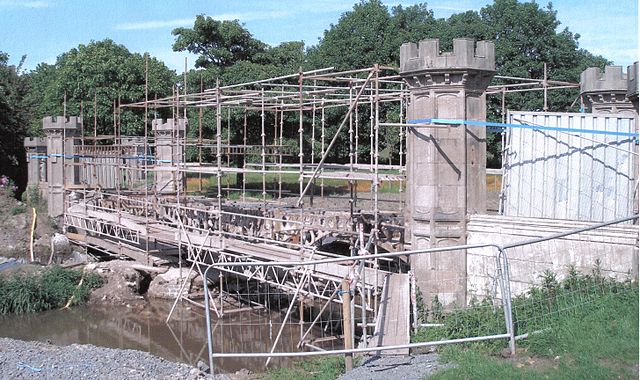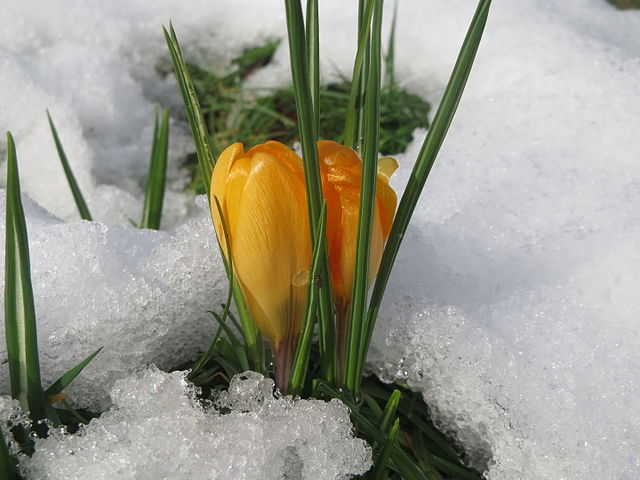
Eglinton Tournament Bridge, image in the public domain, courtesy of Roger Griffith (Rosser1954)
Dungeon23 is an example of worldbuilding as a daily practice. It began (as far as I can tell) with one simple goal and one concrete daily action: create a mega-dungeon by drawing a room every day. Creators worldwide designed their own variations and adaptations. Most that I have seen couple a simple, broad goal with regular, though not necessarily daily, creative action. Part of dungeon23’s appeal is that we feel free to play with the form, setting the goal and practice to meet our own broader creative intentions.
Dungeon23 encourages us to take the intimidating task of deep worldbuilding and break it into small, manageable pieces. We invest a small amount of time and creative energy each day and by and by, we earn ourselves a living world. We’ve praised the open, flexible nature of the activity, but at some point, you might feel a need for a little more structure. You’ve picked the low-hanging fruit of your worldbuilding endeavor and find that your ideas have become a bit…nebulous.

The Lambda Centauri nebula, public domain image, courtesy of JPL and Wide-field Infrared Survey Explorer (WISE)
One solution is to use the next dungeon23 time block to step back and plan your next few moves. For instance, we stepped back from creating actual space locations in our near-future solar system. Instead, we’re using the dungeon23 time to delve into a short list of bigger questions that could significantly affect our depictions of the future. We started by writing a list of these questions to keep us on track. If, like us, you find that a little externally imposed structure helps you make regular progress, we’ve got some ideas for you.
Lists or outlines are great if you have a strong sense of the scope of your project. When I’m trying something completely new, I get annoyed by suggestions like, “Write a clear outline of your project” or “Now break down your goals into sub-goals.” It’s a new field of endeavor! There are entire undiscovered skill sets lurking in the bushes out there. As a real-world example, my partner thought he knew how to sharpen bladed objects. Then he started wood-turning. I think his words were, “I knew sharpening was important but I didn’t know it was Important!” Suddenly, the scope of his wood-turning project widened to include details of chisel angles (theory, practice, and the role of personal preference), grinding jigs, uses of different grinding wheels, wiring a new light fixture…suffice it to say that his wood turning gets better and better and that more than one chisel has sacrificed noticeable length to the vigorous appetite of the grinding wheel.
Wandering back to the point, if you have plenty of experience in world-building, then using a list or outline or time chart may be a great way to scaffold your project. If you are new to worldbuilding, then leverage someone else’s experience!
I find Patricia C. Wrede’s series, “Fantasy Worldbuilding Questions,” to be very approachable. Once upon a time, that series was up at http://www.sfwa.org/writing/worldbuilding1.htm. That link is no longer functional but the articles can be found thanks to the WayBack Machine. Specifically, for this article I used https://web.archive.org/web/20080714090008/http://www.sfwa.org/writing/worldbuilding1.htm.
Skim through the topics on the first page. If they speak to you, then pick a topic and dive in. Every day, go back to the series, select a topic, and answer a few questions. Don’t try to answer all the questions in every topic. Just pick a few that intrigue you, or challenge you, or that are obvious to you. After a while, your world will start to live.

Snow crocus, courtesy of AnRo0002, CC 1.0 Universal
There are lots of scaffolded exercises in worldbuilding out there. Stephanie Bryant’s “30 days of worldbuilding” http://www.web-writer.net/fantasy/days/ may give you the scaffolding you need. “30 days of worldbuilding” was designed to help writers who were staring into the darkly fearful yet oddly attractive eyes of National Novel Writing Month. What I like about 30 days of worldbuilding is the short scope of the project. Each exercise is meant to take about 15 minutes, so for a total investment of 7.5 hours, you have a world. However. I’ll be honest: I don’t like the way the exercises are framed or the ‘hooks’ at the beginning of the exercises. If the series works for you, great. If not, don’t let that turn you off worldbuilding. Keep looking for resources that speak to you. Perhaps Elizabeth Ann Viau’s course on building your own world as in literal planet would be more suitable (again, the original website http://curriculum.calstatela.edu/courses/builders/ is gone but thanks to the WayBack Machine, you can still access all the course materials).
Any of these resources are best suited to deep worldbuilding: adding details to your setting that your characters may or may not ever see but are there for them to discover. Worldbuilding as a daily practice is great for settings in which you plan to tell several (or many) stories. If you have an idea that’s good for one adventure, this is too large an investment of time and effort. If you have an idea that you think will span two or three novels, that’s the setting to focus your deep worldbuilding efforts.
Now, having said that, you can abridge these resources to spark a single fast worldbuilding effort. Just for kicks, let’s dive in to a few of Patricia C. Wrede’s questions. Some adventures I write take place in the fantasy world of Ablia. Ablia is an example of bottom-up design. Each time I go back to it, I write just enough to discover or support the next story. Right now, I have a stalled story set in a village built out on a lake. The village is modeled after the real-world village of Biskupin, which I learned about in one of my weirdly looping JSTOR searches.*
Back to the point (it’s one of those days). So, there I am with a great setting and a stalled story. Let’s see if a little world-building will pull me out of the rut. This is real-time worldbuilding. The answer may be ‘No’.
Okay, basics. This is Ablia: it has magic, it has as many magical beasts as I find convenient for my stories, it has Earth-like gravity, axial tilt, and climate range because those decisions let me save my worldbuilding efforts for story-driven details. Yes, there are absolutely continents. You’ll find out more about them when I do. On we go.
Climate, geography, and resources next. Focusing on this tiny region of the world, we have a lake. It’s a large lake with a settlement built out of logs anchored in the middle of it. For whatever reason, I like the idea of a good solid river in and out of the lake, maybe even a waterfall. After all, this is a culture that went to the tremendous effort of building out in the middle of a lake. Security was apparently on their minds. I’m not sure who they were securing themselves against yet but we’ll pencil in some white water or waterfalls or both.
What about resources? Fish in the lake, aquatic birds on the lake, reeds on the edges, plenty of animals in and around the lake. Animals. Hmm. That reminds me, a friend of mine was saying just last week, “When in doubt, add a sea monster.”
Okay. So let’s say there’s a group of lake-dwelling beings. How would the newcomers fail to notice them while the building was going on? The village is anchored to the lake bed with sunken tree trunks. In all that underwater construction, why weren’t the lake-dwelling beings noticed? Well, perhaps they weren’t there. Perhaps they live like salmon. Okay, that’s a little insulting if they are sentient which I am beginning to think they are but I mean, perhaps they have a regular route, moving around a set of lakes connected by rivers, streams, and one fearsome underground passage (no, I don’t know whether it will ever have a story impact but I like the idea of spelunking. It would take an exceptionally large bet to get me into an undersea cave but that’s a separate matter).
Let’s say it takes years to make one circuit; five, ten, even twenty. They come back to their favorite lake, high, peaceful, and rich in resources, and find an entirely unwelcome village parked in their home. How would they react?
The people of the village moved to this lake because it was secure: high, hard to reach, hard to attack. They may be refugees from a war (Ablia’s had a few) or from more local aggression. They may not be entirely innocent in that dispute, whatever it was, but in the end, they walked away. They looked for a place uninhabited by sentient life to re-establish their culture and picked this lake. Now, they find they’ve spent two or three years building on another culture’s home. How do they react?
I think it has the makings of an interesting adventure. PCs could come from either culture. The first challenge is getting each other talking. While some groups could take the conflict in a violent direction, I hope most would explore more diplomatic solutions.
Will it ever be finished? I don’t know. But it has a better chance now that I’ve built a little more of the world.
*On a related note, if you find yourself stuck for story material, JSTOR is a marvelous resource. Free accounts allow access to a certain number of recent articles a month (and a lot of older articles don’t count against your total). You may have access to more through a public or university library.
0 Comments